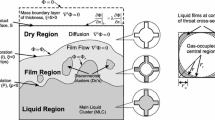Abstract
By utilising the effect of interfacial curvature on the freezing-point of liquids confined in capillaries, it is in principle possible to determine a pore-size distribution, from the curve of freezing-point against volume frozen. The method is formally similar to capillary condensation methods based on the Kelvin equation. Suitable experimental techniques are described. A comparison with the results of mercury porosimetry on a sample of brick shows reasonable agreement.
Résumé
L’effet de la courbure interfaciale sur le point de congélation de liquides retenus dans des capillaires permet, en principe, de déterminer une distribution du diamètre des pores, d’après la courbe point de congélation/volume congelé. On procède à un examen des bases théoriques et l’on montre qu’il existe une similitude formelle avec les méthodes par condensation capillaire qui reposent sur l’équation de Kelvin. Quelques incertitudes théoriques subsistent, qui dépendent principalement du modèle défini adopté pour représenter les configurations de la glace, de l’eau et de l’air dans les pores; mais la comparaison entre les résultats expérimentaux et ceux que l’on peut déduire de la théorie permet de les éliminer. On examine également les effets des sels dissous et de l’hystérésis entre la fusion et la congélation. On décrit des techniques expérimentales appropriées, tant dilatométriques que calorimétriques. Les résultats s’accordent assez bien avec ceux obtenus sur un échantillon de brique par la porosimétrie au mercure.
Similar content being viewed by others
References
Bigg E.K.—The supercooling of water. Proc. Phys. Soc., London, B 66 (1953), 688.
Blachere J.R., Young J.E.—The freezing point of water in porous glass. J. Amer. Ceram Soc., 55 (1972), 306.
Croney D., Coleman J.D., Bridge P.M.—The suction of moisture held in soil and other porous material, Road Res. Techn. Paper No. 24, London, Her Majesty’s Stat. Office, 1952.
Feldman R.F.—Length change-adsorption relations for the water-porous glass system to −40°C. Canad. J. of Chem., 48 [2] (1970), 287.
Gregg S.J., Sing K.S.W.—Adsorption, surface area and porosity. Academic Press, London, 1967.
Anonymous.—Handbook of Chemistry and Physics. 45th Edition 1964–65. The Chemical Rubber Co.
Helmuth R.A.—Capillary size-restrictions on ice-formation in hardened Portland cement-pastes. Proc. Vol. II, 4th, Int. Symp. Chem. of Cement, Washington, D.C. (1960), 855.
Hesstvedt E.—The interfacial energy ice/water. Norwegian Geotechnical Institute, publ. No. 56, Oslo, 1964, 7.
Kubelka P.—Über den Schnelzpunkt in sehr engen kapillaren. Ztschr. Elektrochem. Bd. 38 [8 a], (1932), 611.
Litvan G.G.—Phase transitions of adsorbates: IV Mechanism of frost action in hardened cement paste. J. Amer. Ceram. Soc., 55 (1972), 38.
Lœwenstein K.L.—Glass systems. Composite materials, pp. 129–220. Elsevier Publ. Comp., Amsterdam/London/New York (1966).
Powers T.C., Helmuth R.A.—Theory of volume changes in hardened Portland cement-paste during freezing. HRB. Proceedings 32 (1953), 285.
Powers T.C., Brownyard T.L.—Physical properties of cement-paste. Res. Labs. Portl. Cem. Ass. Bulletin, 22, Chicago, 1948.
Powers T.C., Copeland L.E., Hayes J.C., Mann H.M. —Permeability of Portland cement-paste. Proc. Amer. Concr. Inst., 51 (1954–55), 285.
Puri B.R., Sharma L.R., Lakhanpal K.L.—Freezing-point of water held in porous bodies at different vapour pressures. J. Phys. Chem., 58 (1954), 289.
Schofield R.K.—The pF of water in soil, 3 rd. Int. Congr. Soil. Sci., 2 (1935), 37; 3 (1935), 182.
Schofield R.K., Da Costa J.V.B.—The measurements of pF in soil by freezing-point. J. Agric. Sci., 28 (1938), 645.
Sill R.C., Skapski A.S.—Method for the determination of the surface tension of solids from their melting points in thin wedges. J. Chem. Phys. 24 (1956), 644.
Vos B.H., Tammes E.—Moisture and moisture transfer in porous materials. Report No. BI-69-96. TNO Delft, 1969.
Vuorinen J.—On use of dilation factor and degree of saturation in testing concrete for frost-resistance. Nordisk Betong, 1970: 1, 37.
Washburn E.W.—The vapour pressure of ice and of water below the freezing point. Monthly Weather Rev. (Oct. 1924), 488.
Wheeler A.—Reaction rates and selectivity in catalyst pores. Catalysis Part II. Ed. P.H. Emmett. Rheinhold Publ. Corp. N.Y. 1955, 105.
Williams P.J.—Properties and behaviour of freezing soils. Norwegian Geotechnical Institute. Publ. No. 72, Oslo, 1967.
Winslow D.N., Diamond S.—A mercury porosimetry study of the evaluation of porosity in Portland cement. J. of Materials, Vol. 5, [3] (1970), 564.
Sneck T., Oinonen H.—Measurements of pore size distribution of porous materials. The State Inst. for Techn. Res., Finland, Publ. No. 155, Helsinki (1970).
Author information
Authors and Affiliations
Rights and permissions
About this article
Cite this article
Fagerlund, G. Determination of pore-size distribution from freezing-point depression. Mat. Constr. 6, 215–225 (1973). https://doi.org/10.1007/BF02479036
Issue Date:
DOI: https://doi.org/10.1007/BF02479036




